check engine FIAT FIORINO 2017 Owner handbook (in English)
[x] Cancel search | Manufacturer: FIAT, Model Year: 2017, Model line: FIORINO, Model: FIAT FIORINO 2017Pages: 272, PDF Size: 5.87 MB
Page 148 of 272
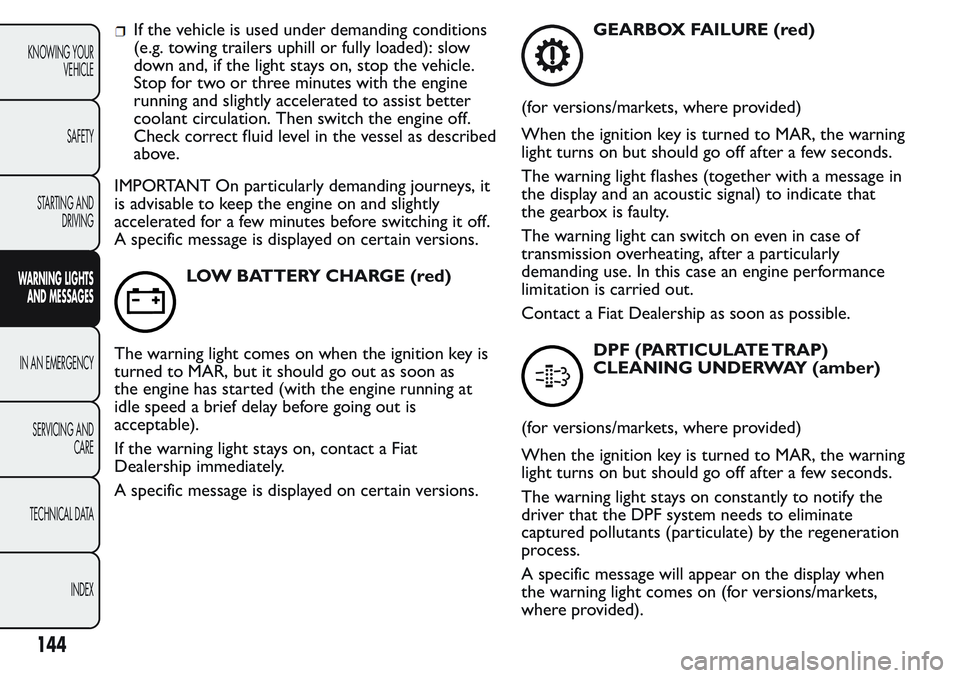
If the vehicle is used under demanding conditions
(e.g. towing trailers uphill or fully loaded): slow
down and, if the light stays on, stop the vehicle.
Stop for two or three minutes with the engine
running and slightly accelerated to assist better
coolant circulation. Then switch the engine off.
Check correct fluid level in the vessel as described
above.
IMPORTANT On particularly demanding journeys, it
is advisable to keep the engine on and slightly
accelerated for a few minutes before switching it off.
A specific message is displayed on certain versions.
LOW BATTERY CHARGE (red)
The warning light comes on when the ignition key is
turned to MAR, but it should go out as soon as
the engine has started (with the engine running at
idle speed a brief delay before going out is
acceptable).
If the warning light stays on, contact a Fiat
Dealership immediately.
A specific message is displayed on certain versions.
GEARBOX FAILURE (red)
(for versions/markets, where provided)
When the ignition key is turned to MAR, the warning
light turns on but should go off after a few seconds.
The warning light flashes (together with a message in
the display and an acoustic signal) to indicate that
the gearbox is faulty.
The warning light can switch on even in case of
transmission overheating, after a particularly
demanding use. In this case an engine performance
limitation is carried out.
Contact a Fiat Dealership as soon as possible.
DPF (PARTICULATE TRAP)
CLEANING UNDERWAY (amber)
(for versions/markets, where provided)
When the ignition key is turned to MAR, the warning
light turns on but should go off after a few seconds.
The warning light stays on constantly to notify the
driver that the DPF system needs to eliminate
captured pollutants (particulate) by the regeneration
process.
A specific message will appear on the display when
the warning light comes on (for versions/markets,
where provided).
144
KNOWING YOUR
VEHICLE
SAFETY
STARTING AND
DRIVING
WARNING LIGHTS
AND MESSAGES
IN AN EMERGENCY
SERVICING AND
CARE
TECHNICAL DATA
INDEX
Page 151 of 272
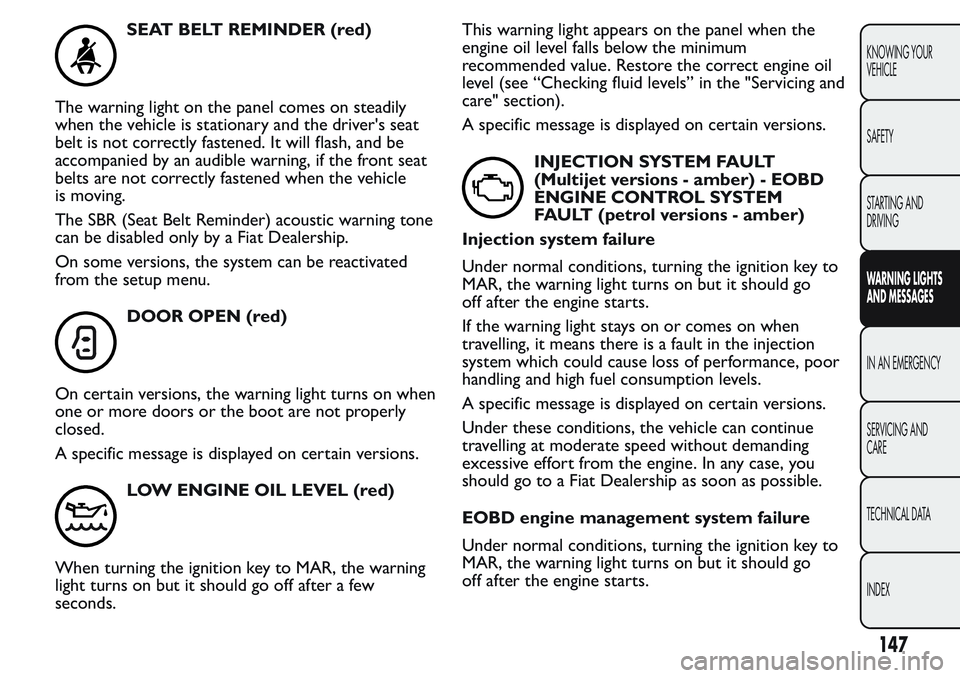
SEAT BELT REMINDER (red)
The warning light on the panel comes on steadily
when the vehicle is stationary and the driver's seat
belt is not correctly fastened. It will flash, and be
accompanied by an audible warning, if the front seat
belts are not correctly fastened when the vehicle
is moving.
The SBR (Seat Belt Reminder) acoustic warning tone
can be disabled only by a Fiat Dealership.
On some versions, the system can be reactivated
from the setup menu.
DOOR OPEN (red)
On certain versions, the warning light turns on when
one or more doors or the boot are not properly
closed.
A specific message is displayed on certain versions.
LOW ENGINE OIL LEVEL (red)
When turning the ignition key to MAR, the warning
light turns on but it should go off after a few
seconds.This warning light appears on the panel when the
engine oil level falls below the minimum
recommended value. Restore the correct engine oil
level (see “Checking fluid levels” in the "Servicing and
care" section).
A specific message is displayed on certain versions.
INJECTION SYSTEM FAULT
(Multijet versions - amber) - EOBD
ENGINE CONTROL SYSTEM
FAULT (petrol versions - amber)
Injection system failure
Under normal conditions, turning the ignition key to
MAR, the warning light turns on but it should go
off after the engine starts.
If the warning light stays on or comes on when
travelling, it means there is a fault in the injection
system which could cause loss of performance, poor
handling and high fuel consumption levels.
A specific message is displayed on certain versions.
Under these conditions, the vehicle can continue
travelling at moderate speed without demanding
excessive effort from the engine. In any case, you
should go to a Fiat Dealership as soon as possible.
EOBD engine management system failure
Under normal conditions, turning the ignition key to
MAR, the warning light turns on but it should go
off after the engine starts.
147
KNOWING YOUR
VEHICLE
SAFETY
STARTING AND
DRIVING
WARNING LIGHTS
AND MESSAGES
IN AN EMERGENCY
SERVICING AND
CARE
TECHNICAL DATA
INDEX
Page 152 of 272
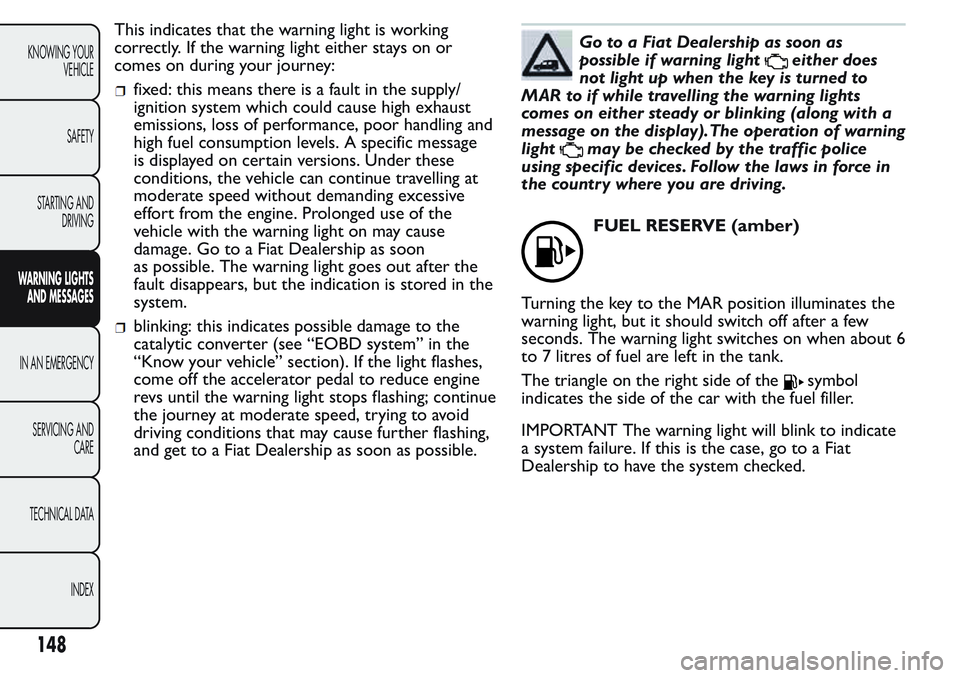
This indicates that the warning light is working
correctly. If the warning light either stays on or
comes on during your journey:
fixed: this means there is a fault in the supply/
ignition system which could cause high exhaust
emissions, loss of performance, poor handling and
high fuel consumption levels. A specific message
is displayed on certain versions. Under these
conditions, the vehicle can continue travelling at
moderate speed without demanding excessive
effort from the engine. Prolonged use of the
vehicle with the warning light on may cause
damage. Go to a Fiat Dealership as soon
as possible. The warning light goes out after the
fault disappears, but the indication is stored in the
system.
blinking: this indicates possible damage to the
catalytic converter (see “EOBD system” in the
“Know your vehicle” section). If the light flashes,
come off the accelerator pedal to reduce engine
revs until the warning light stops flashing; continue
the journey at moderate speed, trying to avoid
driving conditions that may cause further flashing,
and get to a Fiat Dealership as soon as possible.
Go to a Fiat Dealership as soon as
possible if warning light
either does
not light up when the key is turned to
MAR to if while travelling the warning lights
comes on either steady or blinking (along with a
message on the display).The operation of warning
light
may be checked by the traffic police
using specific devices. Follow the laws in force in
the country where you are driving.
FUEL RESERVE (amber)
Turning the key to the MAR position illuminates the
warning light, but it should switch off after a few
seconds. The warning light switches on when about 6
to 7 litres of fuel are left in the tank.
The triangle on the right side of the
symbol
indicates the side of the car with the fuel filler.
IMPORTANT The warning light will blink to indicate
a system failure. If this is the case, go to a Fiat
Dealership to have the system checked.
148
KNOWING YOUR
VEHICLE
SAFETY
STARTING AND
DRIVING
WARNING LIGHTS
AND MESSAGES
IN AN EMERGENCY
SERVICING AND
CARE
TECHNICAL DATA
INDEX
Page 155 of 272
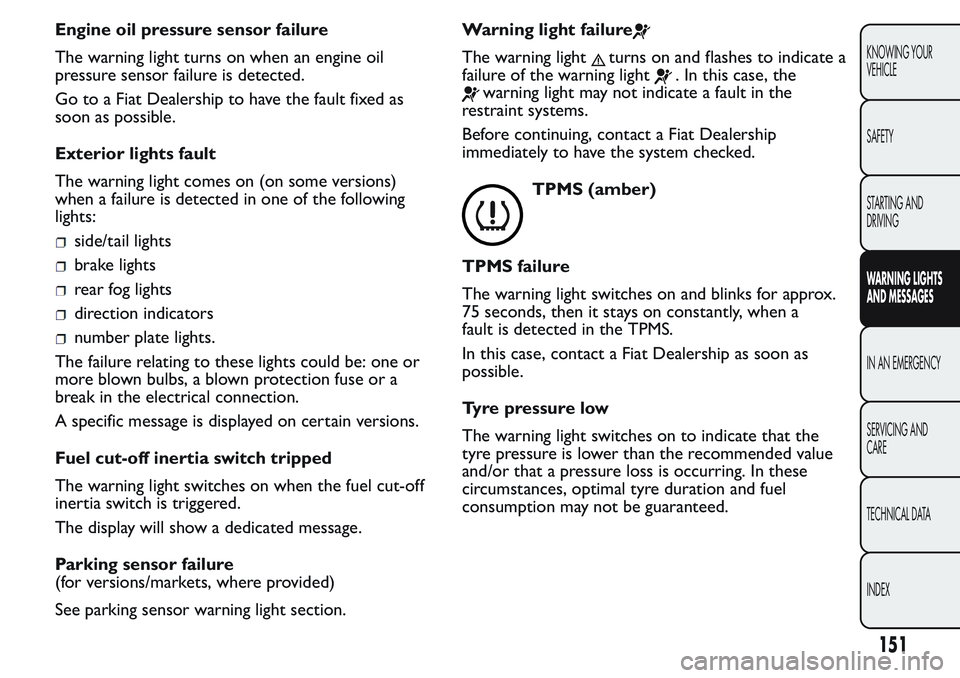
Engine oil pressure sensor failure
The warning light turns on when an engine oil
pressure sensor failure is detected.
Go to a Fiat Dealership to have the fault fixed as
soon as possible.
Exterior lights fault
The warning light comes on (on some versions)
when a failure is detected in one of the following
lights:
side/tail lights
brake lights
rear fog lights
direction indicators
number plate lights.
The failure relating to these lights could be: one or
more blown bulbs, a blown protection fuse or a
break in the electrical connection.
A specific message is displayed on certain versions.
Fuel cut-off inertia switch tripped
The warning light switches on when the fuel cut-off
inertia switch is triggered.
The display will show a dedicated message.
Parking sensor failure
(for versions/markets, where provided)
See parking sensor warning light section.Warning light failure
The warning lightturns on and flashes to indicate a
failure of the warning light
. In this case, the
warning light may not indicate a fault in the
restraint systems.
Before continuing, contact a Fiat Dealership
immediately to have the system checked.
TPMS (amber)
TPMS failure
The warning light switches on and blinks for approx.
75 seconds, then it stays on constantly, when a
fault is detected in the TPMS.
In this case, contact a Fiat Dealership as soon as
possible.
Tyre pressure low
The warning light switches on to indicate that the
tyre pressure is lower than the recommended value
and/or that a pressure loss is occurring. In these
circumstances, optimal tyre duration and fuel
consumption may not be guaranteed.
151
KNOWING YOUR
VEHICLE
SAFETY
STARTING AND
DRIVING
WARNING LIGHTS
AND MESSAGES
IN AN EMERGENCY
SERVICING AND
CARE
TECHNICAL DATA
INDEX
Page 161 of 272
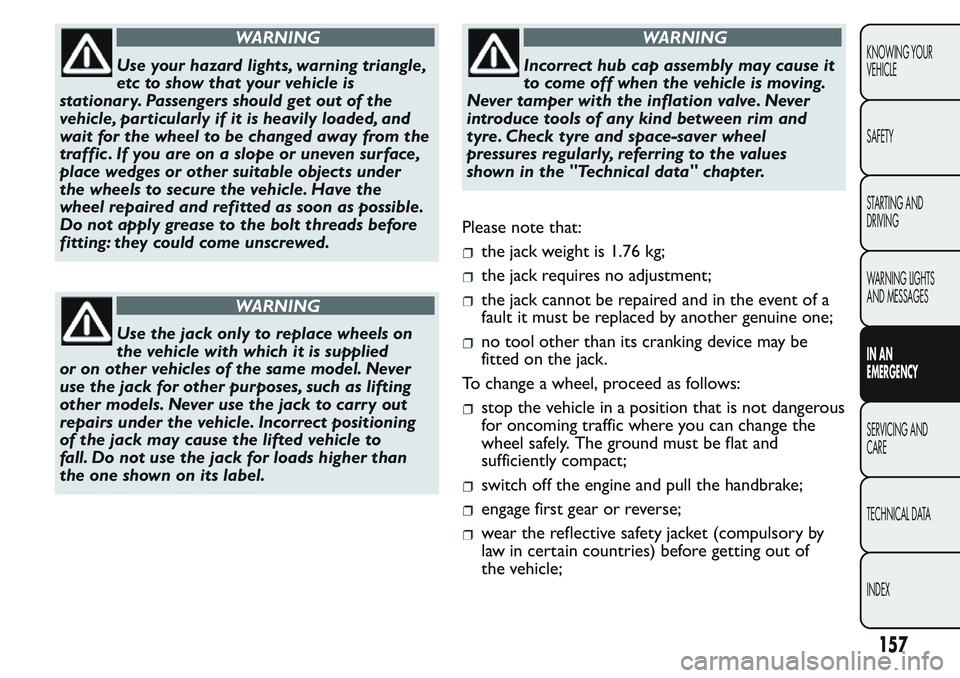
WARNING
Use your hazard lights, warning triangle,
etc to show that your vehicle is
stationar y. Passengers should get out of the
vehicle, particularly if it is heavily loaded, and
wait for the wheel to be changed away from the
traffic . If you are on a slope or uneven surface,
place wedges or other suitable objects under
the wheels to secure the vehicle. Have the
wheel repaired and refitted as soon as possible.
Do not apply grease to the bolt threads before
fitting: they could come unscrewed.
WARNING
Use the jack only to replace wheels on
the vehicle with which it is supplied
or on other vehicles of the same model. Never
use the jack for other purposes, such as lifting
other models. Never use the jack to carr y out
repairs under the vehicle. Incorrect positioning
of the jack may cause the lifted vehicle to
fall. Do not use the jack for loads higher than
the one shown on its label.
WARNING
Incorrect hub cap assembly may cause it
to come off when the vehicle is moving.
Never tamper with the inflation valve. Never
introduce tools of any kind between rim and
tyre. Check tyre and space-saver wheel
pressures regularly, referring to the values
shown in the "Technical data" chapter.
Please note that:
the jack weight is 1.76 kg;
the jack requires no adjustment;
the jack cannot be repaired and in the event of a
fault it must be replaced by another genuine one;
no tool other than its cranking device may be
fitted on the jack.
To change a wheel, proceed as follows:
stop the vehicle in a position that is not dangerous
for oncoming traffic where you can change the
wheel safely. The ground must be flat and
sufficiently compact;
switch off the engine and pull the handbrake;
engage first gear or reverse;
wear the reflective safety jacket (compulsory by
law in certain countries) before getting out of
the vehicle;
157
KNOWING YOUR
VEHICLE
SAFETY
STARTING AND
DRIVING
WARNING LIGHTS
AND MESSAGES
IN AN
EMERGENCY
SERVICING AND
CARE
TECHNICAL DATA
INDEX
Page 195 of 272
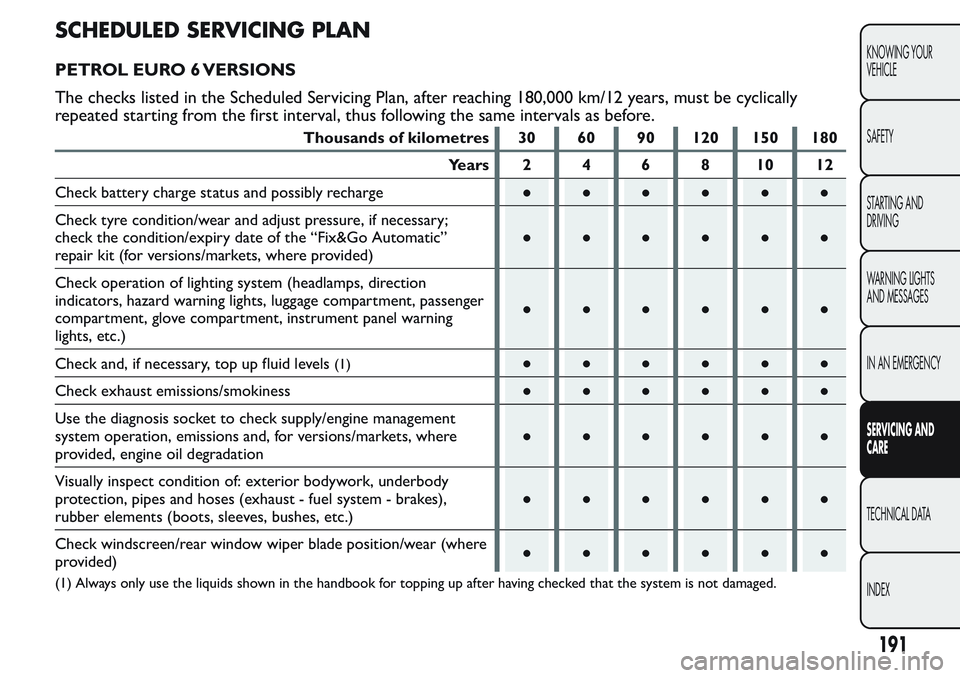
SCHEDULED SERVICING PLAN
PETROL EURO 6 VERSIONS
The checks listed in the Scheduled Servicing Plan, after reaching 180,000 km/12 years, must be cyclically
repeated starting from the first interval, thus following the same intervals as before.
Thousands of kilometres 30 60 90 120 150 180
Years 2 4 6 8 10 12
Check battery charge status and possibly recharge●●●●●●
Check tyre condition/wear and adjust pressure, if necessary;
check the condition/expiry date of the “Fix&Go Automatic”
repair kit (for versions/markets, where provided)●●●●●●
Check operation of lighting system (headlamps, direction
indicators, hazard warning lights, luggage compartment, passenger
compartment, glove compartment, instrument panel warning
lights, etc.)●●●●●●
Check and, if necessary, top up fluid levels
(1)●●●●●●
Check exhaust emissions/smokiness●●●●●●
Use the diagnosis socket to check supply/engine management
system operation, emissions and, for versions/markets, where
provided, engine oil degradation●●●●●●
Visually inspect condition of: exterior bodywork, underbody
protection, pipes and hoses (exhaust - fuel system - brakes),
rubber elements (boots, sleeves, bushes, etc.)●●●●●●
Check windscreen/rear window wiper blade position/wear (where
provided)●●●●●●
(1) Always only use the liquids shown in the handbook for topping up after having checked that the system is not damaged.
191
KNOWING YOUR
VEHICLE
SAFETY
STARTING AND
DRIVING
WARNING LIGHTS
AND MESSAGES
IN AN EMERGENCY
SERVICING AND
CARE
TECHNICAL DATA
INDEX
Page 196 of 272
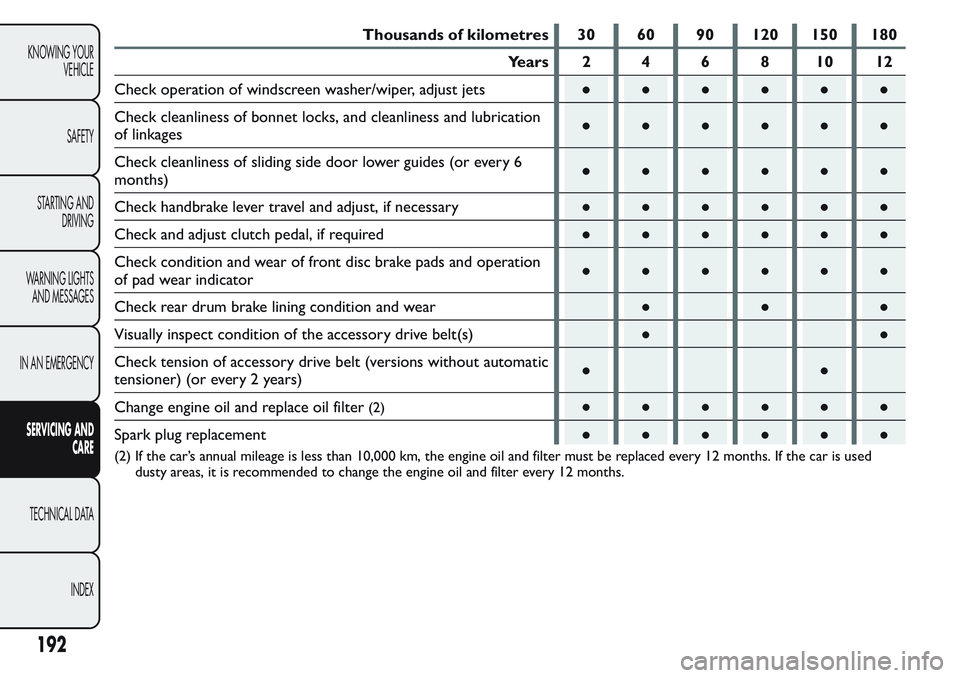
Thousands of kilometres 30 60 90 120 150 180
Years 2 4 6 8 10 12
Check operation of windscreen washer/wiper, adjust jets●●●●●●
Check cleanliness of bonnet locks, and cleanliness and lubrication
of linkages●●●●●●
Check cleanliness of sliding side door lower guides (or every 6
months)●●●●●●
Check handbrake lever travel and adjust, if necessary●●●●●●
Check and adjust clutch pedal, if required●●●●●●
Check condition and wear of front disc brake pads and operation
of pad wear indicator●●●●●●
Check rear drum brake lining condition and wear●●●
Visually inspect condition of the accessory drive belt(s)●●
Check tension of accessory drive belt (versions without automatic
tensioner) (or every 2 years)●●
Change engine oil and replace oil filter
(2)●●●●●●
Spark plug replacement●●●●●●
(2) If the car’s annual mileage is less than 10,000 km, the engine oil and filter must be replaced every 12 months. If the car is used
dusty areas, it is recommended to change the engine oil and filter every 12 months.
192
KNOWING YOUR
VEHICLE
SAFETY
STARTING AND
DRIVING
WARNING LIGHTS
AND MESSAGES
IN AN EMERGENCY
SERVICING AND
CARE
TECHNICAL DATA
INDEX
Page 198 of 272
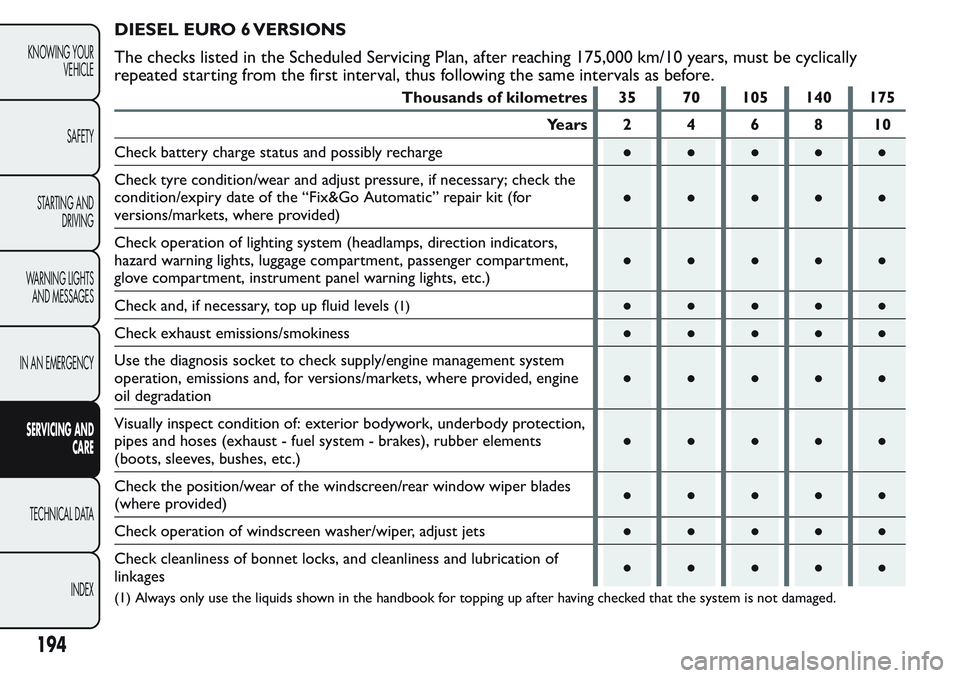
DIESEL EURO 6 VERSIONS
The checks listed in the Scheduled Servicing Plan, after reaching 175,000 km/10 years, must be cyclically
repeated starting from the first interval, thus following the same intervals as before.
Thousands of kilometres 35 70 105 140 175
Years 2 4 6 8 10
Check battery charge status and possibly recharge●●●●●
Check tyre condition/wear and adjust pressure, if necessary; check the
condition/expiry date of the “Fix&Go Automatic” repair kit (for
versions/markets, where provided)●●●●●
Check operation of lighting system (headlamps, direction indicators,
hazard warning lights, luggage compartment, passenger compartment,
glove compartment, instrument panel warning lights, etc.)●●●●●
Check and, if necessary, top up fluid levels
(1)●●●●●
Check exhaust emissions/smokiness●●●●●
Use the diagnosis socket to check supply/engine management system
operation, emissions and, for versions/markets, where provided, engine
oil degradation●●●●●
Visually inspect condition of: exterior bodywork, underbody protection,
pipes and hoses (exhaust - fuel system - brakes), rubber elements
(boots, sleeves, bushes, etc.)●●●●●
Check the position/wear of the windscreen/rear window wiper blades
(where provided)●●●●●
Check operation of windscreen washer/wiper, adjust jets●●●●●
Check cleanliness of bonnet locks, and cleanliness and lubrication of
linkages●●●●●
(1) Always only use the liquids shown in the handbook for topping up after having checked that the system is not damaged.
194
KNOWING YOUR
VEHICLE
SAFETY
STARTING AND
DRIVING
WARNING LIGHTS
AND MESSAGES
IN AN EMERGENCY
SERVICING AND
CARE
TECHNICAL DATA
INDEX
Page 199 of 272
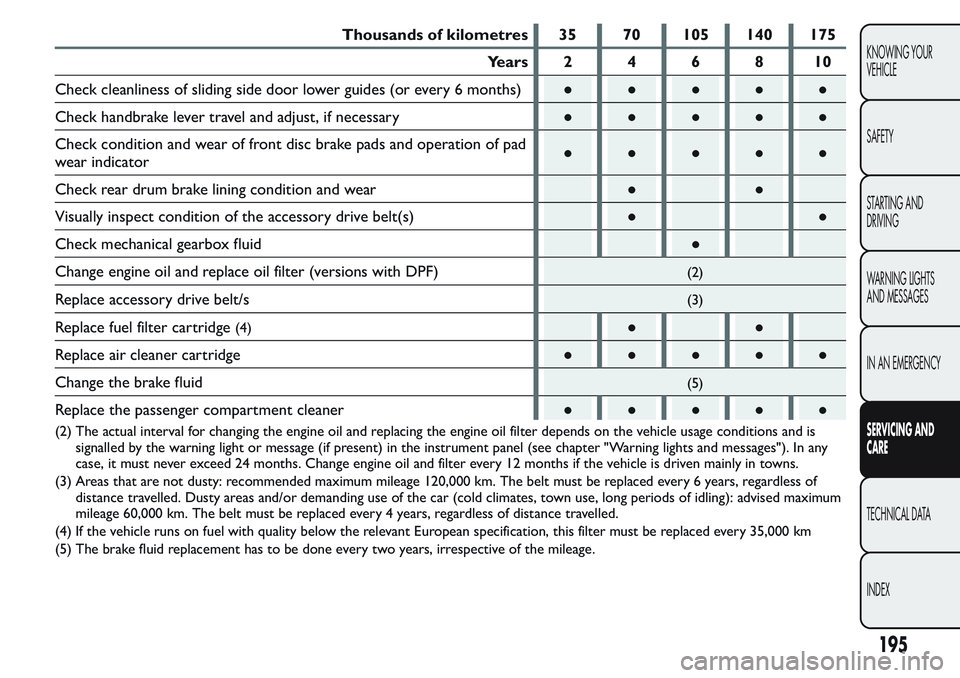
Thousands of kilometres 35 70 105 140 175
Years 2 4 6 8 10
Check cleanliness of sliding side door lower guides (or every 6 months)●●●●●
Check handbrake lever travel and adjust, if necessary●●●●●
Check condition and wear of front disc brake pads and operation of pad
wear indicator●●●●●
Check rear drum brake lining condition and wear●●
Visually inspect condition of the accessory drive belt(s)●●
Check mechanical gearbox fluid●
Change engine oil and replace oil filter (versions with DPF)
(2)
Replace accessory drive belt/s(3)
Replace fuel filter cartridge(4)●●
Replace air cleaner cartridge●●●●●
Change the brake fluid
(5)
Replace the passenger compartment cleaner●●●●●
(2) The actual interval for changing the engine oil and replacing the engine oil filter depends on the vehicle usage conditions and is
signalled by the warning light or message (if present) in the instrument panel (see chapter "Warning lights and messages"). In any
case, it must never exceed 24 months. Change engine oil and filter every 12 months if the vehicle is driven mainly in towns.
(3) Areas that are not dusty: recommended maximum mileage 120,000 km. The belt must be replaced every 6 years, regardless of
distance travelled. Dusty areas and/or demanding use of the car (cold climates, town use, long periods of idling): advised maximum
mileage 60,000 km. The belt must be replaced every 4 years, regardless of distance travelled.
(4) If the vehicle runs on fuel with quality below the relevant European specification, this filter must be replaced every 35,000 km
(5) The brake fluid replacement has to be done every two years, irrespective of the mileage.
195
KNOWING YOUR
VEHICLE
SAFETY
STARTING AND
DRIVING
WARNING LIGHTS
AND MESSAGES
IN AN EMERGENCY
SERVICING AND
CARE
TECHNICAL DATA
INDEX
Page 200 of 272
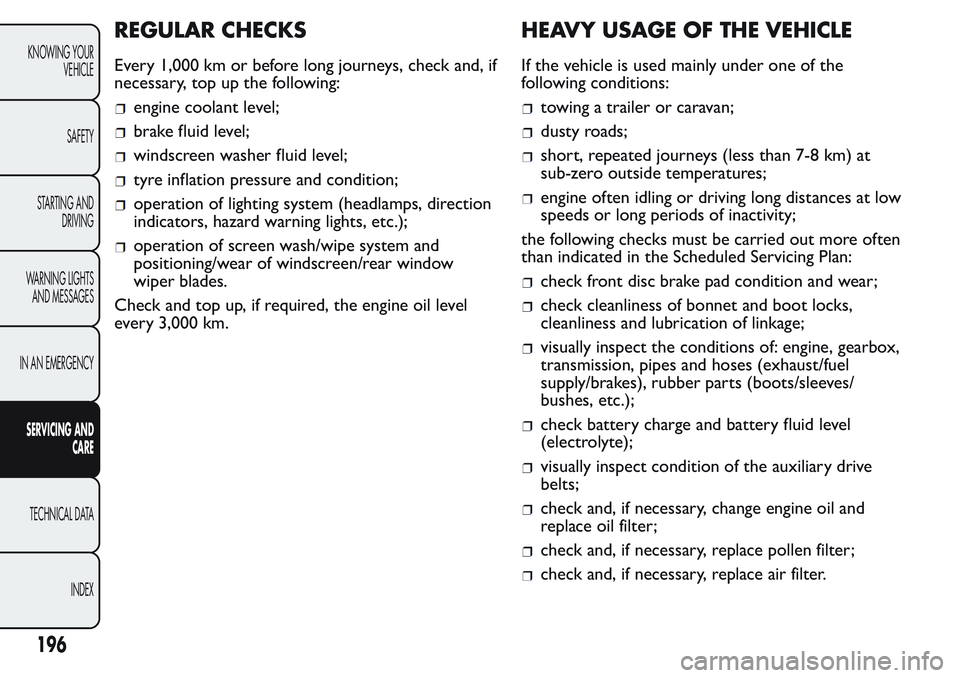
REGULAR CHECKS
Every 1,000 km or before long journeys, check and, if
necessary, top up the following:
engine coolant level;
brake fluid level;
windscreen washer fluid level;
tyre inflation pressure and condition;
operation of lighting system (headlamps, direction
indicators, hazard warning lights, etc.);
operation of screen wash/wipe system and
positioning/wear of windscreen/rear window
wiper blades.
Check and top up, if required, the engine oil level
every 3,000 km.
HEAVY USAGE OF THE VEHICLE
If the vehicle is used mainly under one of the
following conditions:
towing a trailer or caravan;
dusty roads;
short, repeated journeys (less than 7-8 km) at
sub-zero outside temperatures;
engine often idling or driving long distances at low
speeds or long periods of inactivity;
the following checks must be carried out more often
than indicated in the Scheduled Servicing Plan:
check front disc brake pad condition and wear;
check cleanliness of bonnet and boot locks,
cleanliness and lubrication of linkage;
visually inspect the conditions of: engine, gearbox,
transmission, pipes and hoses (exhaust/fuel
supply/brakes), rubber parts (boots/sleeves/
bushes, etc.);
check battery charge and battery fluid level
(electrolyte);
visually inspect condition of the auxiliary drive
belts;
check and, if necessary, change engine oil and
replace oil filter;
check and, if necessary, replace pollen filter;
check and, if necessary, replace air filter.
196
KNOWING YOUR
VEHICLE
SAFETY
STARTING AND
DRIVING
WARNING LIGHTS
AND MESSAGES
IN AN EMERGENCY
SERVICING AND
CARE
TECHNICAL DATA
INDEX